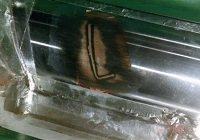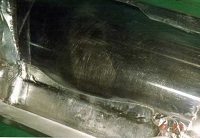170 years ago, in 1847 Richard March Hoe patented, and put into commercial use, the rotary printing press he invented 4 years prior. A rotary printing press uses a rotating drum; and text and images are curved around the cylinder when printed. To this day, keeping the surface of the cylinder in faultless condition, is of the utmost importance.

Mechanical damage ranging from pitting and minor dings and scratches to deep impressions on the cylinder can occur frequently, resulting in errors in printing or complete inoperability of the press. Using brush plating, damage can be repaired permanently, saving time and money. Defects are typically filled with one or more layers of copper, each usually 0.015” thick, and then covered with a hard, wear resistant deposit that has good release or wetting characteristics.
Brush plated deposits are quickly and uniformly applied to damaged areas of cylinders in-place, at scheduled down times, so that the production schedule is not affected.
The photos shows the stages of an in-place repair to correct the damage caused by a dropped allen wrench. Repairs such as this are easily carried out on rolls made of carbon or stainless steel that have been plated with chrome or nickel. This repair was carried out during a normal shut down period with no lost production time.
The sharp edges of the depression were carefully removed with a small high-speed grinder to provide a smooth, gradual transition from the base of the defect to the outer roll surface. Three layers of copper were applied, then dressed a couple of thousandths below the roll surface. Finally, a thin layer of nickel-cobalt was applied to a slightly larger area and then feathered and polished to match the texture of the roll surface.
For more information on brush plating applications in the pulp and paper industry, click here.

 Chinese (Simplified)
Chinese (Simplified)  English (UK)
English (UK)  French
French  German
German  Spanish
Spanish  Swedish
Swedish 

